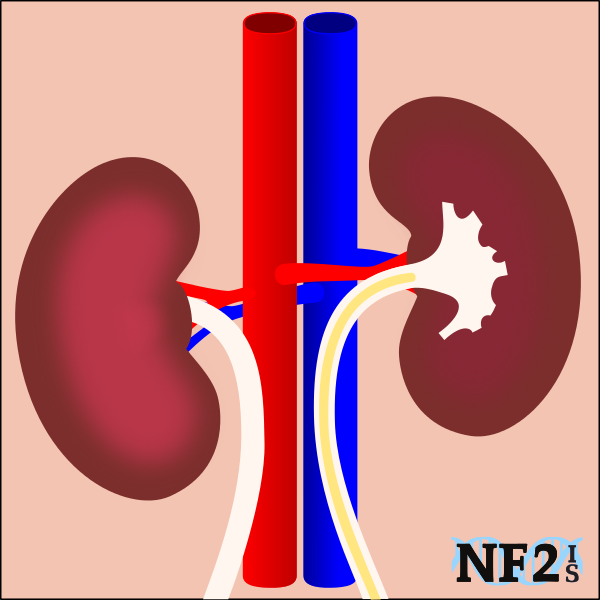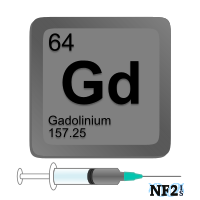Home > Treatment Options > Medication Side Effects >
Medications and Kidney Failure
Last Updated: 12/3/18

Index
- Kidney Function
- Some Reasons for Kidney
Damaging - Determining Kidney Health
- Preventing Kidney Damage
- Summary
Also See:
- Information Related to -
Gadolinium (Gd)
Individuals with neurofibromatosis type 2 (NF2) are at risk of development of kidney failure, or renal failure. Risk of possible kidney failure is from medication, not the NF2 condition.
1. Kidney Function
The kidneys are a pair of vital organs that perform many functions to keep the blood clean and chemically balanced. It is easier to maintain healthy kidneys than it is to recover from poor kidney health.
Only one working kidney is needed, but treatments a person might be receiving will damage both kidneys equally. Once a certain level of damage occurs, Dialysis, a weekly treatment to purify the blood might be required. A kidney transplant might even be needed.
2. Some Reasons for Kidney Damaging
Some of the treatments that can damage the kidneys include:
- MRI Contrast Injection: gadolinium-based (Gd)
- CT Scans: Iodine-containing contrast medium (ICCM)
- Other Risks with Gd
- Drug-based Tumor Treatments: NF2 Clinical Trials
- Pain Medication: Ibuprofen (Motrin)
- High Hemoglobin - Overconsumption of Iron in food or vitamins
- Overconsumption of Water
1. MRI Contrast Injection: gadolinium-based (Gd) 

Gadolinium (GD), MRI contrast agents, are a group of contrast compounds used to improve the visibility of internal body structures for magnetic resonance imaging (MRI). The most commonly used compounds for contrast enhancement include a selection of different Gd compounds.
During an MRI/MRA test to enhance what the scans show an injection of a Gd-based agent is necessary. There are known possible side effects of these agents that could range from mild discomfort during and for a few hours after the injection, but with repeated injections over time can result in kidney problems including possible renal failure (kidney failure).
In 2016, researchers confirmed a new contrast agent of iron oxide nanoparticles could potentially replace the Gd-based agents for MRI/MRA contrasts. Recently related information of trials with iron oxide nanoparticles in animals including; rabbits, dogs, and macaque monkeys have so far proven it is as safer than Gd.
CT Scans: Iodine-containing contrast medium (ICCM)
It has also shown it can distinguish differences from; air, hemorrhage (strokes), calcification, metal deposition, and blood clots, some of which required CT scans with ionizing radiation, a scan type that alone could result in tumor growth.
Other Risks with Gd
Gadolinium has been found to be retained in bone, skin and organs skin, but it also crosses the blood-brain barrier (BBB) where it accumulates in highly sensitive brain tissue. Gadolinium is also toxic to the liver, brain, white blood cells, and damages DNA.
2. Drug-based Tumor Treatments: Bevacizumab (Avastin™)
The problem for a tumor growth condition without a cure is that Tumor Inhibitors taken, like Avastin, can only be taken until the side effects outweigh the advantages of the treatment. This is why no medication has risen past Clinical Trial level. The risk of kidney kailure is one reason why tests are taken before each treatment of Avastin is given.
3. Pain Medication: Ibuprofen (Motrin)
The pain medication of Ibuprofen (Motrin) is often taken for body pain and can be more effective than other over the counter pain medications.
It is a commonly used medication for body nerve pain when peripheral neuropathy is an issue. Peripheral Neuropathy starts out as signs of poor circulation until it develops into nerve and muscle pain, but a regular overabundance of Motrin can easily result in kidney failure and kidneys should be monitored and taking Motrin should be switched to a prescription.
Peripheral Neuropathy is a common NF2 issue but is also caused by other health issues as well.
3. Determining Kidney Health
"Creatinine is a waste product from the normal breakdown of muscle tissue. As creatinine is produced, it is filtered through the kidneys and excreted in urine. Doctors measure the blood creatinine level as a test of kidney function. The kidneys' ability to handle creatinine is called the creatinine clearance rate, which helps to estimate the glomerular filtration rate (GFR) - the rate of blood flow through the kidneys." [WebMD]
There are health issues that could be the result of poor kidney health or other health issues, and yet a person can have poor kidney health without having any symptoms. But kidney health can be easily detected through routine tests. Kidney health can be easily determined with a Urine Test, or Blood Test for; Serum Creatinine (0.6 to 1.2 mg/dl is considered normal range), or blood urea nitrogen (BUN) (7 and 20 mg/dl is considered a normal range).[WebMD, 'Tests Kidney Function']
Individuals who think they might have poor kidney health may want to indicate it as a possible issue to a doctor before blood and urine tests are done. This is also a reason for yearly blood and urine tests, during routine yearly physical
3. Preventing Kidney Damage
Simple things can be done to minimize the risk of damage to the Kidneys, including:
- Blood Test
- Fluids
- Fruits and Vegetables
- Iron
- Protein
- Things to Avoid
1. Blood Test
Blood tests to check kidney health is important for doctors of individuals with NF2. While the test alone would not prevent kidney damage, it would help determine what changes might be needed in either medication or dietary change.
Blood testts to monitor kidney helth is an important setp when taking tumor-drug treatments. Kidney health is often the reason for discontinuation or breaks of of tumor-drug treatments.
2. Fluids
Drinking as much water as possible the same day as receiving a treatment that may damage kidneys, in addition to regular water consumption, in general, can help. This can also include fruit juices, ginger ale, or no caffine tea, like green tea or cammomile. To avoid dehydration the day of treatment avoiding coffee is also recommended and otherwise try to drink no more than two cups of coffee daily.
3. Fruits and Vegetables
Eating a diet rich in fruits and vegetables, and low in salt or oxalate-rich food can help prevent mineral build up while avoiding foods high in potassium including bananas. Some of those include:
- Fruit: Cherries, grapefruit, grapes, mangoes, melons, green plums, yellow plums, and nectarines.
- Vegetables: Cabbage, chives, cauliflower, cucumbers, endive, kohlrabi, mushrooms, radishes, water chestnuts, and peas.
- Meat and Seafood: Lean beef, fish (except for sardines), lamb, poultry, pork, and shellfish.
- Dairy: Cheese, milk, and buttermilk
- Starches: Barley, corn and rice-based cereals, egg noodles, English muffins, graham crackers, plain pasta, wild rice, and white rice.
4. Iron
If you know you are already experiencing some amount of poor kidney function, eating iron-rich foods can help. Some of these things include; red meat, egg yolks, dark leafy greens (spinach, collards), and dried fruit (prunes, raisins).
5. Protein
Protein is important to the body. It helps the body repair muscles and fights disease. Protein comes mostly from meat but can also be found in eggs, milk, nuts, beans, and other foods.
Some doctors tell their kidney patients to limit without avoiding the amount of protein they eat, so the kidneys have less work to do.
6. Things to Avoid
Nicotine is a stimulating drug and can cause blood vessels to constrict, or become smaller. When blood flow to the kidneys is reduced, people can sustain damage to the glomerulus, which is the filter of the kidney.
4. Summary
Regular doses of treatments that are potentially harmful to kidneys increases the risk of permanent damage. Chances of issues are even higher when tumor inhibitors, or chemotherapy agents, are taken and require additional MRIs.
Consider items listed under Preventing Kidney Damage, to help can help prevent damage the fluid listing is the most important on prevention and follow up with your doctors about tests to check kidney health.
5. Sources
- Reginster P, Martin B, Denolin V. Neurooncol Open Access. "Comparative Study of Pseudo-Continuous Arterial Spin
Labeling and Dynamic Susceptibility Contrast Imaging at 3.0 Tesla in Brain Tumors." (2017), 2: 1.
Source: http://j-neurooncology.imedpub.com/comparative-study-of-pseudocontinuous-arterial-spin-labeling-and-dynamic-susceptibility-contrast-imaging-at-30-tesla-in-brain-tumo.pdf | DOI: DOI: 10.21767/2572-0376.100018 - Science Daily. New MRI contrast agent tested on big animals (August 2017)
Source: https://www.sciencedaily.com/releases/2017/07/170731114502.htm - Yang Lu, Yun-Jun Xuer al. "Iron oxide nanoclusters for T 1 magnetic resonance imaging of non-human primates."
Nature Biomedical Engineering. (2017)
Source: https://www.nature.com/articles/s41551-017-0116-7 | DOI: 10.1038/s41551-017-0116-7 - National Library of Medicine. PubMed Health. "Ibuprofen (By mouth)." (2018)
Source: http://www.ncbi.nlm.nih.gov/pubmedhealth/PMHT0010648/?report=details - U.S. Department of Health and Human Services "Kidney Disease." (2018)
Source: http://kidney.niddk.nih.gov/kudiseases/pubs/yourkidneys - SF GATE. Healthy Eating. "The Best Foods to Increase Kidney Function" (2018)
Source: http://healthyeating.sfgate.com/foods-increase-kidney-function-6538.html - SF GATE. Healthy Eating. A List of Low-Oxalate Foods." (2018)
Source: http://healthyeating.sfgate.com/list-lowoxalate-foods-5398.html - American Cancer Society. "Anemia in People With Cancer." (2018)
Source: http://www.cancer.org/treatment/treatmentsandsideeffects/physicalsideeffects/anemia/anemia-in-people-with-cancer - WebMD. "Creatinine and Creatinine Clearance Blood Tests" (2018)
Source: http://www.webmd.com/a-to-z-guides/creatinine-and-creatinine-clearance-blood-tests - WebMd. "Tests Kidney Function" (2018)
Source: http://www.webmd.com/a-to-z-guides/tests-kidney-function - Science Daily. "A new contrast agent for MRI" (February 14, 2017)
Source: https://www.sciencedaily.com/releases/2017/02/170214162741.htm - MedSight. "MRI Contrast Gadolinium." (2018)
Source: https://medinsight.org/mri-contrast-gadolinium/ - CBS News. "Chuck Norris Says MRI Chemical Poisoned His Wife."
Source: https://www.cbsnews.com/news/chuck-norris-says-mri-chemical-poisoned-his-wife/ - "The Best Foods to Increase Kidney Function" http://healthyeating.sfgate.com/foods-increase-kidney-function-6538.html
-
"Artificial intelligence helps reduce gadolinium dose in MR imaging."
https://physicsworld.com/a/artificial-intelligence-helps-reduce-gadolinium-dose-in-mr-imaging/ -
National Kidney Foundation (NKF). "Dialysis."
https://www.kidney.org/atoz/content/dialysisinfo -
National Kidney Foundation (NKF). "Glomerular Filtration Rate (GFR)."
https://www.kidney.org/atoz/content/gfr


 |Google Play
|Google Play